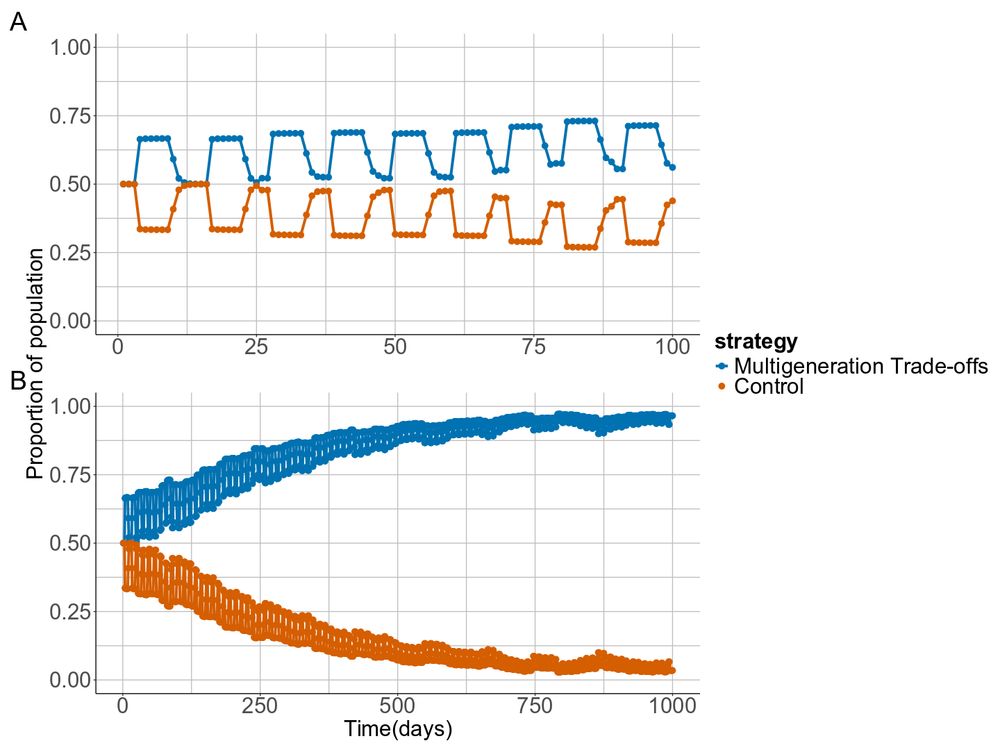
Alexei Maklakov
@alexeimaklakov.bsky.social
Biology of Ageing and Life History Evolution, University of East Anglia, Norwich, UK
10/ This suggests the idea that transgenerational effects are can be just a delayed cost of intergenerational benefits. We discuss a TE/small-RNA-based “multigenerational trade-off” hypothesis that could generate these patterns and reconcile previous work. The end.

November 5, 2025 at 12:26 PM
10/ This suggests the idea that transgenerational effects are can be just a delayed cost of intergenerational benefits. We discuss a TE/small-RNA-based “multigenerational trade-off” hypothesis that could generate these patterns and reconcile previous work. The end.
9/ Result: the genotype with short-term F1 gains but F3 costs can still win and nearly fix in the population, because selection mostly “sees” the immediate advantage before the debt comes due

November 5, 2025 at 12:24 PM
9/ Result: the genotype with short-term F1 gains but F3 costs can still win and nearly fix in the population, because selection mostly “sees” the immediate advantage before the debt comes due
8/ We then built boom-and-bust population simulations, comparing:
🧬 a genotype with this F1 benefit + F3 cost
vs
🧬 a genotype with no inter/transgenerational effects
🧬 a genotype with this F1 benefit + F3 cost
vs
🧬 a genotype with no inter/transgenerational effects
November 5, 2025 at 12:23 PM
8/ We then built boom-and-bust population simulations, comparing:
🧬 a genotype with this F1 benefit + F3 cost
vs
🧬 a genotype with no inter/transgenerational effects
🧬 a genotype with this F1 benefit + F3 cost
vs
🧬 a genotype with no inter/transgenerational effects
7/ Crucially, these patterns hold across matched and mismatched environments!! (starved vs ad lib)
So this isn’t just “good if the environment repeats” - looks like a more general multigenerational trade-off
So this isn’t just “good if the environment repeats” - looks like a more general multigenerational trade-off
November 5, 2025 at 12:23 PM
7/ Crucially, these patterns hold across matched and mismatched environments!! (starved vs ad lib)
So this isn’t just “good if the environment repeats” - looks like a more general multigenerational trade-off
So this isn’t just “good if the environment repeats” - looks like a more general multigenerational trade-off
6/ Then we looked at great-grand-offspring (F3).
Here, the story flips
Descendants of starved ancestors showed:
⬇️ lifetime reproduction
⬇️ λ
⬇️ survival
The F1 benefits are paid for by F3
Here, the story flips
Descendants of starved ancestors showed:
⬇️ lifetime reproduction
⬇️ λ
⬇️ survival
The F1 benefits are paid for by F3

November 5, 2025 at 12:22 PM
6/ Then we looked at great-grand-offspring (F3).
Here, the story flips
Descendants of starved ancestors showed:
⬇️ lifetime reproduction
⬇️ λ
⬇️ survival
The F1 benefits are paid for by F3
Here, the story flips
Descendants of starved ancestors showed:
⬇️ lifetime reproduction
⬇️ λ
⬇️ survival
The F1 benefits are paid for by F3
5/ But their direct offspring (F1) did surprisingly well – regardless of whether they were starved or well-fed:
⬆️ reproduce earlier
⬆️ higher λ
⬆️ better survival in at least some environments
Short-term starvation of parents - better offspring - looks like starved parents invest more per offspring
⬆️ reproduce earlier
⬆️ higher λ
⬆️ better survival in at least some environments
Short-term starvation of parents - better offspring - looks like starved parents invest more per offspring

November 5, 2025 at 12:22 PM
5/ But their direct offspring (F1) did surprisingly well – regardless of whether they were starved or well-fed:
⬆️ reproduce earlier
⬆️ higher λ
⬆️ better survival in at least some environments
Short-term starvation of parents - better offspring - looks like starved parents invest more per offspring
⬆️ reproduce earlier
⬆️ higher λ
⬆️ better survival in at least some environments
Short-term starvation of parents - better offspring - looks like starved parents invest more per offspring
4/ First, the obvious: starved worms (P0) paid a price
⬇️ lifetime reproduction
⬇️ rate-sensitive fitness λ
⬇️ survival
Reproduced later, produced fewer offspring overall
⬇️ lifetime reproduction
⬇️ rate-sensitive fitness λ
⬇️ survival
Reproduced later, produced fewer offspring overall

November 5, 2025 at 12:20 PM
4/ First, the obvious: starved worms (P0) paid a price
⬇️ lifetime reproduction
⬇️ rate-sensitive fitness λ
⬇️ survival
Reproduced later, produced fewer offspring overall
⬇️ lifetime reproduction
⬇️ rate-sensitive fitness λ
⬇️ survival
Reproduced later, produced fewer offspring overall
3/ We looked intergenerational and transgenerational effects of larval starvation in C. elegans

November 5, 2025 at 12:19 PM
3/ We looked intergenerational and transgenerational effects of larval starvation in C. elegans
2/ Previous work by others suggested that intergeneration effects can trade-off with other, see for example: elifesciences.org/articles/73425
elifesciences.org
November 5, 2025 at 12:18 PM
2/ Previous work by others suggested that intergeneration effects can trade-off with other, see for example: elifesciences.org/articles/73425

